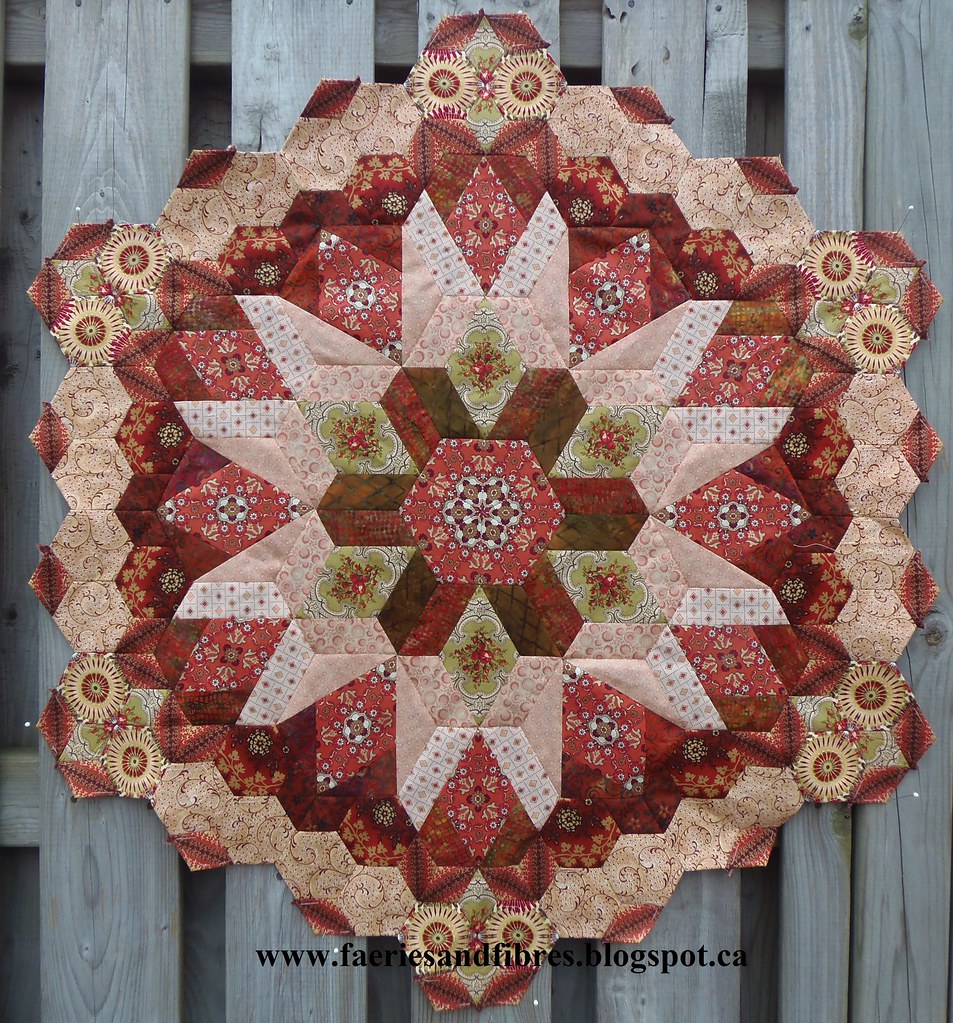If you are visiting for my Grow Your Blog post & Giveaway please click here.
I've started the four filler pieces for the top, bottom and sides of the medallion for my hexagon quilt
Birds in the Loft. I decided I want to repeat the bird fabric that I used in the centre. I didn't want to
make oval frames like I did for the birds in the middle.
Birds in an oval frame in the centre of the medallion for Birds in the Loft
The reason is that the way I've designed the medallion calls for hexagon frames but I wanted to soften the inner edges of these frames to mimic the centre birds. Let me show you what I mean!
I started by making the frame with hexagons.
I want a nice soft curve on the inside of the oval so I folded the points of the hexagons under on the inner edge. I basted with thread and pressed the whole thing with a hot, dry iron. This is what the frame looks like from the front. Now if you're wondering why I didn't modify the shape of the paper templates rather than turning under the points it is because I found that the inner edge where the hexagons meet is not as smooth. If you prefer to modify your individual paper hexagons by cutting off the points rather than making basted hexagons and folding under the points by all means do so!
This is what the frame looks like from the back.
The next step was to rough cut the bird that will fit inside the frame. I did this by laying the frame on the fabric and tracing around the inside edge with a chalk pencil. I cut out the bird leaving a generous allowance of 3/4" to 1" beyond the chalk line.
The final step was to position the hexagon frame on the bird and glue baste it in place with my
Roxanne Glue Baste-It. You only need tiny dots of that glue to hold the frame to the fabric.
I appliqued the frame to the bird with Superior's
The Bottom Line in a taupe colour. A fine applique needle was used and when I was doing the applique I was careful to catch just a few of the hexagon threads without catching the paper. Once the applique was completed the basting thread that was used to hold the folded hexagon edges in place was removed. Notice that the brown and white diamond print on the right is a directional print. I made sure that the diamonds radiated out from the centre. The brown on the left is also a directional print but it is such a tiny print that I didn't worry about the fabric placement because it reads as a solid.
The excess red fabric was trimmed from the back to roughly 1/4 - 3/8".
I leave the papers in place until the hexagon is surrounded with other hexagons. I stitched three background hexagons to the right side so that I could demonstrate the piece with some papers removed.
Two of the hexagon papers were removed. Because I was careful not to catch the papers in my applique stitches the papers popped out easily. If you happen to catch a bit of the paper just take extra care in removing the paper. At the orange circles you can see the points of the hexagons that were folded under. They can be trimmed or they can be left as they are; the decision should be based on the on the weight of the fabric. If the fabric is heavier/coarser I would trim. If it is lighter then I would leave the points in place.
That is one frame completed and there are three to go. If you are wondering why I used two browns the answer is simply that I was using up my scrap 2 1/2" strips of fabric! In so doing it adds another design element and it is thrifty because I'm making do!
So there you have it! This is a great way to use your hexagons with beautiful large prints that you don't want to chop up into small pieces. Wouldn't it be great to make a quilt out of framed birds or flowers and you could separate your blocks with a hexagon path? Another option would be to applique these framed pictures to a background square of fabric; the square blocks can be easily stitched together with or without sashing. Just think how quickly you could stitch a hexagon quilt!
I'm linking up with several blogs where you will find tons of creative inspiration:
Until I post again, happy hexagoning!
Karen H




















































